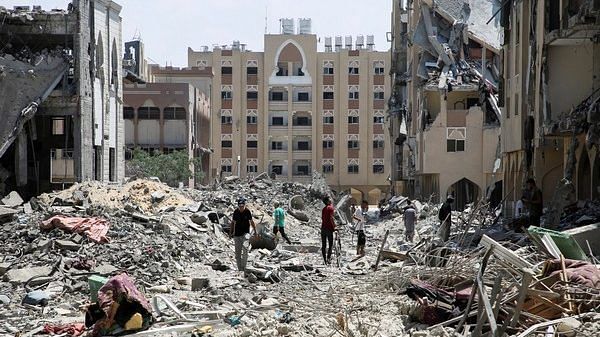Thank you dear subscribers, we are overwhelmed with your response.
Your Turn is a unique section from ThePrint featuring points of view from its subscribers. If you are a subscriber, have a point of view, please send it to us. If not, do subscribe here: https://theprint.in/subscribe/
One year into the Gaza-Israel conflict, Gaza is in ruins, its buildings reduced to rubble, and its people struggling to survive. The war, which began as a battle between Israel and Hamas, has expanded, pulling in Lebanon, Yemen, and Iran. With tensions escalating, the question remains. Is this conflict becoming something far larger?
The Beginning: October 7, 2023
The conflict reignited on October 7, 2023, when Hamas launched a surprise attack from Gaza, killing over 1,200 people and taking more than 250 Israelis hostage. The attack drew immediate condemnation from the United States and other nations, criticizing Hamas for targeting civilians. Israel vowed to respond forcefully, setting the stage for a prolonged and devastating conflict.
Why Did Hamas Attack?
Hamas, which controls Gaza, has long resisted Israel’s military dominance. However, this sudden escalation needs to be examined. For decades, Israel has carried out operations in Palestinian territories, isolating Gaza further. Despite forming peace agreements with other Arab nations like Egypt, Saudi Arabia, and Jordan, Israel’s stance on Palestine remains uncompromising. The refusal to reach a resolution on Palestinian sovereignty and the status of Jerusalem continues to fuel tensions.
Israel has strengthened its position over the years, gaining substantial political and military support, especially from the United States. While it has made peace with countries such as the UAE, Bahrain, Sudan, and Morocco, conflicts with Palestine, Lebanon, and Syria persist. In this context, Hamas’s attack, despite the odds, seems a response to Israel’s growing influence and the unresolved Palestinian issue.
The U.S. Support
The United States remains one of Israel’s strongest allies. Since October 2023, it has provided $12.5 billion in military aid, arguing that Israel has the right to defend itself, despite growing concerns about the impact on civilians in Gaza. While the U.S. has supported Israel militarily, it has also provided humanitarian aid to Gaza’s displaced population, including food and medical supplies.
European nations such as France, have also provided military and financial aid to Israel. However, the continued violence and civilian casualties have led to increased scrutiny and criticism from international observers and human rights organizations.
Gaza’s Devastation
On 2023 October 13, Israel warned northern Gaza residents to relocate southward in preparation for its offensive against Hamas. In the months that followed, Israeli airstrikes destroyed essential infrastructure, including schools, universities, and hospitals. Israel claims these attacks target Hamas fighters who use civilians as human shields. However, the level of destruction has led to questions about Israel’s long-term intentions, with some experts speculating that it aims to annex Gaza.
A year into the conflict, Gaza’s people face unimaginable psychological trauma. The constant barrage of missile strikes and the loss of homes and loved ones have left deep scars. The siege has also deprived the population of basic needs like food, water, and healthcare, further exacerbating the humanitarian crisis.
Fleeing South
In response to the attacks, many Gazans fled southward, seeking refuge in Rafah, near Egypt. Despite international condemnation, Israel launched an offensive on Rafah in May 2024, worsening the humanitarian situation. Reports indicate that the conflict has killed over 41,000 Palestinians, including 11,000 children, and displaced more than two million people. The crisis continues, with aid struggling to reach those in need.
A Regional Conflict Unfolding
As the Gaza conflict intensifies, unrest spreads across the region. Countries like Egypt have facilitated aid deliveries, while nations including the United States and India have provided humanitarian assistance. However, the violence is no longer contained within Gaza’s borders.
Hezbollah, an Iran-backed militia in Lebanon, has joined the conflict, launching attacks against Israel. The Israeli military responded, escalating operations in Lebanon. Tensions peaked on October 8, 2023, when Israel officially declared war on Gaza and opened a northern front with Hezbollah.
Iran’s support for Hezbollah has made it a target for Israeli operations. In April 2024, Israel attacked the Iranian embassy in Syria, killing 13 people. The conflict’s expansion indicates a shift in regional dynamics, with Israel targeting Iranian interests and its allies. This escalation resembles a proxy war, with Iran and its affiliates opposing Israel, backed by the U.S. and Western powers.
The Human Toll and the Path Ahead
After a year of relentless conflict, Gaza faces a staggering human toll. Civilians are caught in a struggle for survival amid the destruction, displacement, and trauma. The siege has left Gazans without essential services, and international aid, though present, is insufficient to address the scale of the crisis. With no signs of resolution, the prospect for peace remains dim, as diplomatic efforts struggle to gain momentum amidst ongoing military actions.
The Gaza-Israel conflict, now entering its second year, serves as a reminder of the region’s volatile history. As tensions rise and violence continues, the broader implications for the Middle East are becoming more apparent. The world watches anxiously as Gaza, and the entire region, teeters on the brink of further catastrophe.
These pieces are being published as they have been received – they have not been edited/fact-checked by ThePrint


